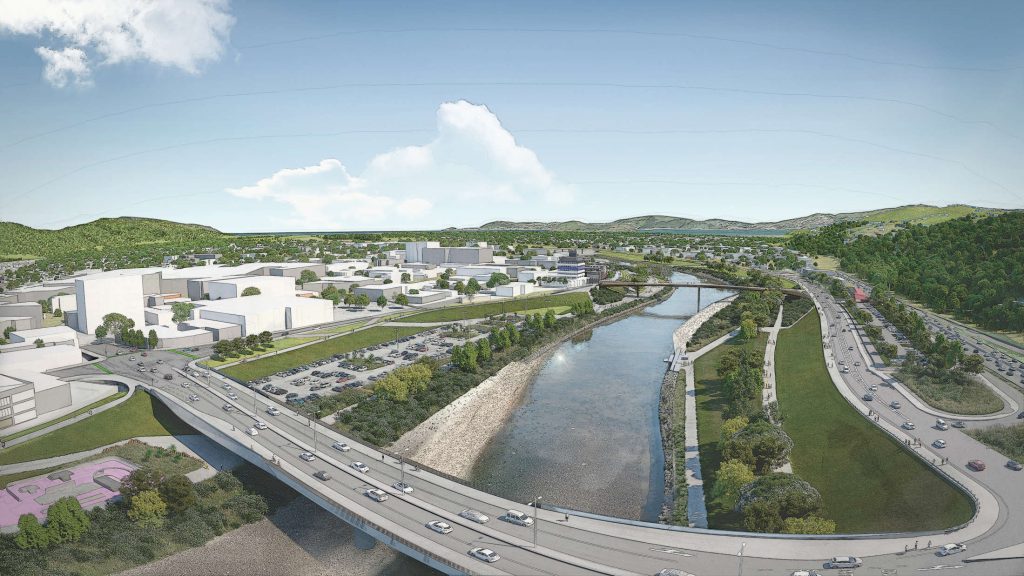“See you in court!”: Cobham Drive, community groups, and judicial review
Posturing aside, what does it really mean for someone to legally challenge a roading authority’s decision – be it a cycleway, a road expansion, or a pedestrian crossing on Cobham Drive?
“See you in court” – again
Wellington Airport’s declaration of intent to torpedo a pedestrian crossing on Cobham Drive is fresh, but recently there’s been a few legal challenges to roading related decisions by various public decision-makers (Waka Kotahi/NZTA and councils). They range from the large-scale Mill Road roadbuilding project, to the very local Thorndon Quay parking changes, and aspects of the Island Bay cycleway.
But what does it mean to take an authority to court over a decision they’ve made?
Pick your decision
As TW readers know well, it’s very rare for road- or street-shaping (or shaping of the stuff inbetween) to be done by just one decision.
Normally they’re the product of a whole sequence of decisions made by officials, with a complex cocktail of inputs that combine into a “sound decision”. See for example: the (unusually well-documented) decision series here and here that (eventually) results in making X and Y changes to City Street, so it’s safe enough for normal people to cycle.
“They got it wrong!”
So you think the decision-makers have got a decision wrong (but can’t say they were grossly negligent)?
Ok, do you also have the resources to challenge the decision? (Because it’s guaranteed to chew up loads of time).
Alright then: there’s a couple of avenues to mount your challenge.

Firstly, there’s the upstream way: getting yourself into the proverbial tent as a “stakeholder” or in a reference group (like the Public Transport Users Group). In particular processes, the law that gives officials power to decide these things (e.g. the RMA) allows interested parties to challenge decisions along the way. (This is what Cycle Wellington are doing in the Riverlink development – more on that below.)
But for challenging a decision made by part of the public sector – from the local council to MBIE – your general-purpose go-to is judicial review. This is the “cause of action” used in the Thorndon Quay, Mill Road, and Island Bay Cycleway cases.
Meet judicial review
As the Island Bay Cycleway case demonstrated, it’s easy to say “we’ll see you in court!” and relatively easy to apply for judicial review. But it’s much harder to get a “win” i.e. the judge ruling that the decision-maker got something wrong.
And then even if you get that “win”, there’s still no guarantee you’ll actually get the on-the-ground result you want. Here’s how it unpacks.
How they decided, not what
“The judge usually won’t look at whether the decision-maker made the “right” decision, but will look instead at the way the decision was made – for example, whether you were given the chance to put your case, and whether the decision-maker considered all the relevant factors.”
Community Law online
“Looking at the way the decision was made” has three key elements: the decision-maker acting outside their powers, or making an unreasonable decision, or adopting an unfair process.
Because we’re only interested in attempts to challenge the substance of the decision (e.g. “we don’t want that new motorway”), we’ll focus on the first two elements.
Acting outside their powers
As a general rule of natural justice, bits of a government exercising power over citizens are only allowed to do so when a law says they can, and exercise it consistently with the whys, hows and wherefores set out in that law. So if (for example) a council tries to exercise its power in a way that isn’t laid out in the empowering law, it’s acting ultra vires (Latin for “outside its powers”). This might be because there simply is no legislative provision authorising what the council is purporting to do, or because the council has mistakenly thought the legislation gives them broader powers than it does.

You can demonstrate a decision-maker was acting ultra vires by showing that the decision-making people took irrelevant stuff into account (“we’re going to reject this subdivision consent because we all think the applicant is a scumbag because he’s been convicted for exploiting workers”).
You could also successfully argue that a decision-maker’s failed to take into account relevant stuff, and a good example is the successful judicial review case of Mill Road (a huge and overwhelmingly car-focussed new road to a big housing development in Auckland). The judge found Auckland Transport and NZTA failed to take into account the Zero Carbon Act and the emissions the new road would create, so they had to make the decision about the road’s shape again. (In the end the government decided to drop it altogether.)
Making an unreasonable decision
Then there’s the argument that the council (or government department or agency) made an unreasonable decision.

In a sense, this is the widest way into the judicial review, where you can try fitting your argument if you think the council “just got it wrong”. But remember, rightness or wrongness isn’t usually what the judge can look at in judicial review. So the standard to convince the court is really, really, high. The decision must be so unreasonable that it is outrageous or simply illogical.
Some things aren’t open to challenge
One feature of a decision isn’t usually open to challenge on review: the weighting of individual factors within a decision.
In the complex cocktail of ingredients into a sound decision, councils are allowed to weigh – for example – an option’s popularity against evidence of its effectiveness, and choose to go with something that’s popular but won’t work (parking policy, anyone?).
Another classic “weighting” that’s not open to challenge is how a council or government agency weighs the interests of immediate neighbours to a project against the interests of others – such as future generations, a viable climate, citywide public health (a common battle around sewerage infrastructure), or the interests of “drivers” or “cyclists”, or other people using the area but not living there.
Various bits of legislation and policy are adding more pressure on decision-makers to weight city-shaping decisions differently from how they have in the past, like the Zero Carbon Act and the (still-forming) nationwide emissions reduction plan and transport sector emissions reduction approach [PDF]. But unless the legislation is clear that one particular consideration in the cocktail should take priority, the courts are not interested in arguments that the decision-maker should have weighed individual decision factors differently.
Judgement: a do-over

So, you’ve got this far in judicial review – what happens if you’re successful?
Irritatingly for applicants for judicial review, the judge declaring a decision was done illegally or unreasonably just means the decision-maker has to go back and do it over. They have to pay more attention to the scope and exercise of their legal powers. And they have to be nice and transparent about it.
So while there may be massive bizarreness, floundering and stuff-ups in arriving at a decision, the do-over may arrive at exactly the same decision just with better process and papertrailing.
So, whither the pedestrian crossing on Cobham Drive?
It’s clear that bringing an application for judicial review, you can’t expect to be successful in just having unreasonable or disproportionate beefs with the decision-making process – as succinctly put by the judge in the Island Bay Cycleway judicial review decision.
You have to show – using evidence of how the decision-makers got to their decision – that it was either beyond their legal powers to make the call in the way they did, OR that given all the things bearing down on the decision-making, it was so unreasonable it was outrageous or illogical.
Our hunch is that it’s going to be an uphill battle to win a judicial review challenge against the decision of Cobham Drive having a pedestrian crossing, on both the dimensions of judicial review.
Has the Cobham Drive decision-making had a failure of process, like acting outside powers?
While LGWM are pretty opaque it’s still clear that the process to get to “yes, a crossing” has had a lot of options analysis, consultations, expert input etcetera etcetera, and no breaches of natural justice.
And obviously it’s 100% within these organisations’ legal powers to make these sorts of calls – it’s the bread-and-butter of their daily work.
So that’s a No on this dimension of judicial review.
Has Cobham Drive had outrageous or simply illogical decision-making?
Here’s a solid summary by The Spinoff from their Bulletin:
Wellington airport is going to court to stop a pedestrian crossing.
[…]To stop people from running across 70kmh traffic between the popular sea path and the Sports Centre, Waka Kotahi wants to install a pedestrian crossing. The nearest one is nearly a kilometre away. As the Dominion Post reports, Wellington airport is demanding a judicial review. The airport argues Cobham Drive is the first experience many have of the capital and the crossing could slow traffic. The average drive to Khandallah could be slowed by 50 seconds. There have been 528 accidents on the road over the past 12 years from [people walking and biking] trying to cross.
So in favour of reasonableness in choosing a crossing there’s:
- deaths, clearly from having no legitimate crossing
- the plans to get fewer cars on the road in the first place, therefore less traffic to hold up (LGWM is charged with reducing our reliance on private vehicles citywide)
- the way higher cost and vulnerability to earthquakes/tsunami of building a crossing that’s up in the air or dug under the ground
And on the side of “it is unreasonable to slow the traffic at all” there’s:
- Wellington Airport’s need to get lots of people driving there in private cars then paying to park in its new $70-million parking building
- its CE’s opinions about visitors’ “good first impressions” of Wellington and that having to sit in traffic is a bad look (seriously)
So unless something dramatic comes out of the woodwork it seems pretty unlikely that a judicial review will succeed.
Hopefully the airport see sense and drop it, as it’s pretty frustrating to consider the cost to the public of defending a judicial review taken by… an entity that’s ⅓ owned by the people of Wellington and has received lots of public money recently. If it goes to court, we’d really hope the public bodies of LGWM would seek to recover costs.

Good luck in court!
In contrast, three legal fights we at Talk Welington are hoping will succeed:
Proper national targets for emissions reduction – judicial review
Lawyers for Climate Action are taking the Climate Change Commission to court seeking judicial review for their undercooked emissions reduction targets for New Zealand.
Not expanding Wellington Airport – appeal to higher court
Guardians of the Bays are appealing the Court decision to allow Wellington Airport to expand, challenging the decision’s reasonableness and/or weighting, pointing to the effects on the climate and also on the neighbourhood (one of Wellington’s poorest).
Decent cycling around Riverlink – it needs your help!
Happening right now, there’s a fight to get the huge government-delivered Riverlink development to provide meaningfully for safe biking in its massive redo of the roads and bridges around Melling.

This isn’t a judicial review or an appeal, rather a part of the RMA’s process for large resource consents: applicants can opt to have everything handed to the Environment Court to decide. This means those wanting to contest decisions have to tool up and participate in court, rather than just in the “tent” at the meeting-room table with the agencies doing the project (and then going to court to contest decisions).
Court is a very expensive process for anyone, let alone a volunteer-run group like Cycle Wellington. The bigger point is that it’s pretty shameful that the three public service agencies doing such a huge project – of which a major aspect is creating a great place to live – should have to be legally forced in court to do basic good practice for communities, climate and public health.
Cycle Wellington’s fundraising for their Environment Court mahi on our and our kids’ behalf deserves our support.
Please throw their Givealittle some coin.
And wish them luck: there’s no “do-over” option as there is with judicial review. If the Environment Court get Riverlink wrong for cycling, the only avenue for appeal is a heftier court.
Further reading:
- An excellent summary of the lessons from the Island Bay Residents’ Association failed judicial review, by law firm Tompkins Wait (and an encouraging coda to that saga)
- A summary of the Lawyers for Climate Action case against the Climate Change Commission, in a useful tracker of pro-climate court cases worldwide
- A history of the excellent community advocacy (including going to court) which helped make Waka Kotahi Auckland/Northland much better at providing for safe cycling from the getgo than Waka Kotahi down here seem to be…
Image credits:
- Banner image – Let’s Get Wellington Moving
- Members only sign – Australian Museum of Democracy
- Powers in suit – uncredited on the internet everywhere
- Chief Justice Elias – Wikipedia
- Riverlink visualisation – Riverlink
Leave a comment